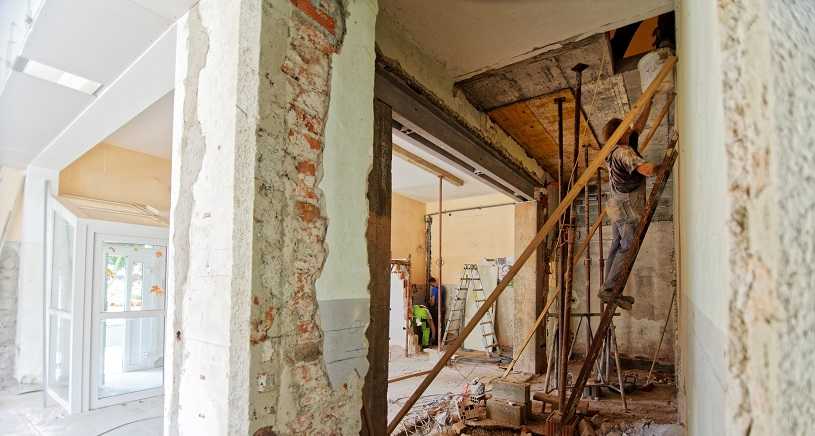Below are the top commercial energy code proposals introduced earlier this month at the 2019 Committee Action Hearings that represent big wins for building efficiency proponents and may be coming to a city near you.

Earlier this month, a group of code officials, manufacturers, designers, and energy efficiency advocates gathered for five days in New Mexico to propose and debate amendments to the 2021 International Energy Conservation Code (IECC). The proposed amendments that make their way to the finish line will be a major factor in future commercial building construction and renovation practices and whether or not structures reach higher levels of efficiency, safety, and resiliency. The official results of the hearings will be published here.
As city and code officials prepare to vote, here is an overview of some of the most impactful proposals that are likely to become a part of the 2021 IECC and may eventually impact your jurisdiction:
1. Pushing the Building Envelope
Multiple code proposals recommended small upgrades across the building thermal envelope. To effectively make a building more energy-efficient and resilient, the envelope has to be the number one priority. Without a properly sealed and insulated envelope, a building will continue to waste energy and money and be exposed to outdoor pollutants, among other negative effects. During the hearings, clarity was brought to the issue of what is technically considered to be the building envelope, addressing concrete slab edges that often go under-insulated or don’t have any insulation period. This clarification will help designers and code officials eliminate thermal breaks that are critical to the success of code provisions that require envelope improvements. In addition to the thermal envelope, the committee focused on the issue of air barriers and adding air barrier testing as a mandatory requirement to the code. As the committee voted to include this, one member commented, “all of the value we put into our building envelopes will be wasted if we don’t address air leakage.”
With an increase in stringency of R-values and air barrier testing requirements, the next code will invest in the efficiency of the building system with the longest life: the envelope. The roofs, walls, and floors of buildings can remain in place for upwards of 100 years, therefore, changes will ensure that structures built to this standard will save energy across that lifespan.
2. Elevating Transparency
IMT collaborated with the Energy Efficient Codes Coalition to propose a permanent certificate for commercial buildings. Residential certificates have been a requirement since the 2006 version of the IECC. These certificates allow building owners to quickly know what components make up their envelope, HVAC, and other systems to make informed decisions on building upgrades. The certificate proposal for commercial buildings will help owners by requiring information on the design and construction of the envelope be documented in a permanent location. With a view toward performance-based codes and building energy performance standards, this information will be critical in modeling analysis for major upgrades and renovations. The envelope, unlike a new piece of HVAC equipment, does not come standard with an energy efficiency label. With a permanent certificate, that would change for the better.
The committee also accepted a proposal for energy monitoring systems that track building energy by end use. This information can help owners identify issues with specific systems in their buildings, and understand energy use changes that may indicate existing problems. As cities across the U.S. continue to pass building performance policies and building energy performance standards, owners armed with more information about their building energy use will help them make important decisions on where to further invest in efficiency and meet future requirements.
3. Tackling Energy Recovery Ventilation
The IECC will now require multifamily buildings to install energy recovery ventilation. Most multifamily buildings have mechanical designs that exhaust each unit individually. These are simple to design, construct, and understand. They also meet an exception in the current energy code, where if a system’s largest source of exhaust is less than 75% of the designed outdoor air rate it is exempt from energy recovery. None of these small exhausts would meet that cut-off, exempting these buildings from energy recovery. Some in attendance at the Committee Action Hearings noted that if the International Mechanical Code requires ventilation in these units, they should be required to be energy efficient.
4. Decreasing Lighting Power Densities
Lighting power densities (LPD) for both interior and exterior lighting were lowered to be in line with the coming edition of ASHRAE 90.1-2019. While it may not be the most exciting change in the 2021 IECC, proponents and the committee recognized that LPD allowances have been too high and out of step with market technologies for several years/code cycles. Reducing these values eliminates what have been seen as loop holes in the additional efficiency option paths and the performance path by allowing the LPD baseline to be too high.
5. Regulating Plug Loads
For the first time, the 2021 IECC will see the regulation of plug loads. Similar to provisions in ASHRAE 90.1 since 2010, the committee approved a proposal to require 50% of receptacles in certain occupancies to be controlled. While there was and will likely continue to be fierce debate over the potential energy savings (is everyone using extension cords to plug into the uncontrolled outlets?), we know that plug and miscellaneous loads make up an increasing percentage of energy used in our buildings as we make our main systems (envelope, lighting, HVAC and hot water) more efficient. This amendment is the first step at taking those loads seriously in the IECC.
Big Changes Afoot
The biggest changes you are likely to see when the 2021 gets published are structural. The Sustainability, Energy & High-Performance Building Code Action Committee (SEHPCAC) reviewed every code section to determine if it was intended to be mandatory or prescriptive. If the members uphold the committee action, this information will be made more clear than ever – helping code officials interpret and enforce of exactly what can and cannot be traded off under the performance path.
The other structural change is in Section C406—the additional efficiency options. New Buildings Institute and Pacific Northwest National Laboratory completed an analysis of the current options across climate zones and building types, and rated them by potential energy savings. As approved by the committee, this section will now require project teams select from options to earn 10 points. This amendment was followed by other added options to promote design flexibility and properly account for the energy savings obtained by these measures.
There is also a potential new net-zero appendix. Proposed by Architecture 2030, it codifies the ZERO Code as an option for cities to pick up when they adopt the 2021 IECC. IMT will be watching the progress of this proposal closely through to the end of the Public Comment Hearings in October.
Although these changes combined with the significant energy efficiency proposals I noted all seem to have an easy path to adoption at the hearings, there was plenty of opposition and attempts to roll back the efficiency of the current code, and many proposals that were voted down. In my next blog, I’ll provide an overview of those proposals that did not make it but which may resurface at the hearings in October.
Have a question? Send me an email at kimberly.cheslak@imt.org.

